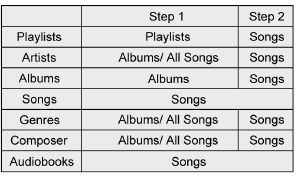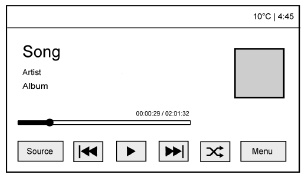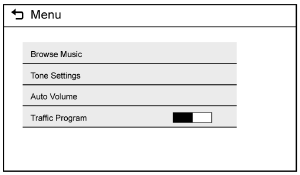Chevrolet Equinox Owners Manual: USB Port
Using the USB Port
The infotainment system can play music by connecting an auxiliary device to the USB port.
USB Support If equipped, there are USB ports on the center stack and inside the center console for data and charging, and may have USB charge ports on the rear of the center console. The USB ports use the USB 2.0 standard.
USB Supported Devices
- USB Flash Drives
- iPods/iPhones
- Portable USB Hard Drives
Not all iPods and USB drives are compatible with the USB port.
Make sure the iPod has the latest firmware from Apple for proper operation. iPod firmware can be updated using the latest iTunes application. See www.apple.com/ itunes in the U.S. and Canada only.
For help with identifying your iPod, go to www.apple.com/support in the U.S. and Canada only.
The USB port can play both lower and upper case .mp3, .wma, .ogg, and .wav files stored on a USB storage device.
Supported Apple Devices
To view supported devices in the U.S., see www.my.chevrolet.com \learned.
To view supported devices in Canada, see www.chevroletowner.ca.
For information on supported devices in Mexico, see your dealer.
USB Supported File and Folder Structure
The infotainment system supports:
- FAT16.
- FAT32.
- exFAT.
Connecting a USB Storage Device or iPod/iPhone
To connect a USB storage device, connect the device to the USB port.
To connect an iPod/iPhone, connect one end of the device's cable to the iPod/iPhone and the other end to the USB port.
The iPod/iPhone charges while it is connected to the vehicle if the vehicle is on or in ACC/ ACCESSORY. See Ignition Positions. When the vehicle is turned off, the iPod/iPhone automatically powers off and will not charge or draw power from the vehicle's battery.
For more information on USB usage, see "Audio System Information" following.
Audio System Information
The infotainment system can play the music files contained in the USB storage device or iPod/iPhone products.
Using MP3/WMA/OGG/WAV Files
- Music files with .mp3, .wma, .ogg, and .wav file name extensions can be played.
- MP3 files that can be played: Bit
rate: 8 kbps to 320 kbps.
Sampling frequency: 48 kHz, 44.1 kHz, 32 kHz, 24 kHz, 22.05 kHz, and 16 kHz.
- Files with a bit rate above 128 kbps will result in higher quality sound.
- ID3 Tag information for MP3 files, such as the album name and the artist, can be played.
- To display album title, track title,
and artist information, the file
should be compatible with the
ID3 Tag V1 and V2 formats.
Using USB Storage Devices and an iPod/iPhone
- Use a USB or flash memory type storage device. Do not connect using a USB adaptor.
- Do not connect and reconnect the USB device repeatedly in a short time, as this may cause static electricity and problems using the device.
- Use a USB device with a metal connecting terminal.
- Connection with i-Stick Type USB storage devices may be faulty due to vehicle vibration.
- Do not touch the USB connecting terminal.
- Only USB storage devices
formatted in FAT16/32 or exFAT
file systems are recognized.
NTFS and other file systems are not recognized.
- The time it takes to process files will depend on the USB storage device type and capacity, and the type of files stored.
- Some USB storage device files may not be compatible.
- Up to two USB devices and one
iPod can be played through a
USB hub. All devices may not be
supported, depending on the
performance of the USB hub.
If there is not enough power supply, it may not operate normally.
- Do not disconnect the USB
storage device while it is playing.
This may cause damage to the product or affect the performance of the USB device.
- Disconnect the USB storage device when the ignition is turned off. If the ignition is turned on while the USB device is connected, the USB device may be damaged or may not operate normally.
- USB storage devices can only be connected for playing music, viewing photo files, or upgrading.
- Do not use the USB terminal to charge USB accessory equipment. The heat generated may cause performance issues or damage.
- Music files to which Digital Right Management (DRM) is applied cannot be played.
- USB storage device that has a
capacity limit of no more than
5,000 files, such as music,
photo, video, 15 levels of folder
structure. Normal usage cannot
be guaranteed for a storage
device that exceeds this limit.
The iPod/iPhone can play all music files that are supported.
The music file lists will only display up to 5,000 files on the screen. These files are sorted in alphabetical order.
- Some iPod/iPhone product models may not support the connectivity or functionality of this product.
- Only connect the iPod/iPhone with connection cables supported by iPod/iPhone products. Other connection cables cannot be used.
- The iPod/iPhone may be
damaged if it is connected to the
vehicle with the ignition on.
When not in use, disconnect the iPod/iPhone.
- When the iPod/iPhone is connected to the USB port by using the iPod/iPhone cable, the Bluetooth music is not supported.
- The iPod/iPhone playback functions and the information displayed may be different when played on the infotainment system.

- Refer to the table for the classification items related to the search function provided by the iPod/iPhone.
USB Player
Playing Music from a USB Device
- Connect the USB device to the USB port.
- Play will start automatically after the system has finished reading the USB device.
- If a non-readable USB device is connected, an error message displays and the system will switch to the previous audio function.

If the USB device is already connected:
- Press {.
- Touch AUDIO.
- Touch Source.
- Touch USB.
To stop the USB device and select another media source, touch Source, then select the other source.
To remove the USB device, select another function, then remove the USB device.
Pause
- Touch
 to pause.
to pause. - Touch
 to resume.
to resume.
Changing to Next/Previous Files
- Touch
 to change to the
next file.
to change to the
next file. - Touch
 within five
seconds of
the playback time to play the
previous file.
within five
seconds of
the playback time to play the
previous file.
Returning to the Beginning of the Current File
Touch after five seconds of the
playback time.
after five seconds of the
playback time.
Scanning Forward or Backward
Touch and hold  or
or during
playback to rewind or fast forward.
during
playback to rewind or fast forward.
Release to resume playback at normal speed.
Playing Files Randomly
Touch  during playback.
during playback.
- ON: Plays all files randomly.
- OFF: Returns to normal playback.
Using the USB Music Menu

- Touch Menu during playback.
- Touch the desired menu.
- Applicable audio extensions are asx, m3u, .pls, .wpl, b4s, and .xspf.
Browse Music
- Touch Browse Music.
- Touch the desired music.
Tone Settings
Touch Tone Settings. The Tone Settings menu is displayed. See "Tone Settings" under "Radio Controls" in Operation. To stop the device and select another media source, touch Source, then select the other source.
Auto Volume
Touch Auto Volume. The Auto Volume menu is displayed. See "Auto Volume" under "Radio Controls" in Operation.
Traffic Program (If Equipped) Touch On or Off.
MTP (Media Transfer Protocol)
- Connect an MTP supported device.
- Play will start automatically after the system has finished reading the MTP device.
- If a non-readable MTP device is connected, an error message displays and the system will switch to the previous audio function.
iPod/iPhone Player
This feature is limited to models supporting the iPod/iPhone connection.
Playing Music Files
- Connect the iPod/iPhone to the USB port.
- Play will start from the previously played point after the system has finished reading the USB device.
- If a non-readable USB device is connected, an error message displays and the system will switch to the previous audio function.
If the iPod/iPhone is already connected:
- Press
 .
. - Touch AUDIO.
- Touch Source.
- Touch iPod.
To stop the device and select another media source, touch Source, then select the other source.
To remove the device, select another function, then remove the device.
Pause
- Touch
 to pause.
to pause. - Touch
 to resume.
to resume.
Changing to Next/Previous Song
- Touch
 to change to the
next song.
to change to the
next song. - Touch
 within two
seconds of
the playback time to play the
previous file.
within two
seconds of
the playback time to play the
previous file.
Returning to the Beginning of the Current File
Touch after two seconds of the
playback time.
after two seconds of the
playback time.
Scanning Forward or Backward
Touch and hold  or
or during
playback to rewind or fast forward.
during
playback to rewind or fast forward.
Release to resume playback at normal speed.
Playing Files Randomly
Touch  during playback.
during playback.
- ON: Plays all files randomly.
- OFF: Returns to normal playback.
Using the iPod Menu
- Touch Menu during playback.
- Touch the appropriate play mode.
Browse Music
- Touch Browse Music.
- Touch the desired music.
Tone Settings
Touch Tone Settings. The Tone Settings menu is displayed. See "Tone Settings" under "Radio Controls" in Operation.
Auto Volume
Touch Auto Volume. The Auto Volume menu is displayed. See "Auto Volume" under "Radio Controls" in Operation.
Picture System Information
The infotainment system can view picture files stored on a USB storage device and devices that support Media Transfer Protocol (MTP).
- Supported file extensions: .jpg, .bmp, .png, .gif.
- Animated GIF files are not supported.
- Some files may not operate due to a different recording format or the condition of the file.
Viewing Pictures
- Connect the USB device to the USB port.
- Touch the screen to open to full screen. Touch the screen again to return to the previous screen.
If the USB device is already connected:
- Press
 .
. - Touch GALLERY.
Some features are disabled while the vehicle is in motion.
Viewing a Slide Show
- Touch
 from the
picture
screen.
from the
picture
screen. - Touch the screen to cancel the slide show during the slide show playback.
Viewing a Previous or Next Picture
Touch  or
or
 from the picture
screen.
from the picture
screen.
Rotating a Picture
Touch  from the picture screen.
from the picture screen.
Enlarging a Picture
Touch  from the picture screen.
from the picture screen.
Using the USB Picture Menu
- Touch MENU from the picture screen.
- Touch the appropriate menu:
- Slide Show Time: Allows selection of the slide show interval.
- Clock, Temp. Display: Allows selection of On or Off to show the clock and temperature on the full screen.
- Display Settings: Adjusts for Brightness and Contrast.
- Touch
 to exit.
to exit.
 Avoiding Untrusted Media
Devices
Avoiding Untrusted Media
Devices
When using media devices such as
CDs, DVDs, Blu-ray Discs, SD
cards, USB devices, and mobile
devices, consider the source.
Untrusted media devices could
contain files that affect system
operat ...
 Auxiliary Devices
Auxiliary Devices
Using the Auxiliary Input Jack
Settings menus and functions may
vary depending on vehicle options.
The auxiliary input jack can be used
to connect external audio devices
such as an iPod, iPhone ...
Other materials:
Engine Block Assemble Engine Block
Apply sealant to all plugs-(1, 2, 3) prior toinstallation. Refer toAdhesives, Fluids, Lubricants, and Sealers.Install the drain plug, with sealant, in the waterpump.Caution:Refer toFastener Caution.Install the coolant jacket plugs, with sealant, and tightento35-Y(26-lb-ft).Install the rear oil passa ...
